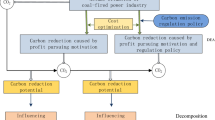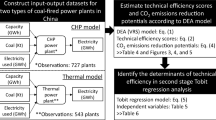Abstract
The demand for energy has continued to increase because of global economic development, which has led to rising fuel prices and continued pollution problems. China is currently the largest coal consumer and is also the largest emitter of coal-fired CO2 emissions. However, past efficiency studies have been mostly limited to static analyses and have not considered undesirable outputs. Therefore, this study developed a bound dynamic directional distance function (DDF) data envelopment analysis (DEA) model to explore the energy and environmental efficiencies in 30 Chinese provinces from 2011 to 2015, from which it was found that (1) the overall efficiency was the best in the eastern region, but relatively low in the western region; (2) Beijing, Guangdong, Jiangsu, Shandong, Shanghai, Tianjin, Jiangxi, Jilin, and some other regions had efficiencies of 1; (3) the revenue and non-coal indicator efficiencies were reasonably good, but the expenditure and emissions efficiencies were generally poor; and (4) the key direction for primary improvements was found to be the emissions index.








Similar content being viewed by others
Data availability
The datasets generated and/or analyzed during the current study are available in the China National Bureau of Statistics (www.stats.gov.cn).
References
BP (2019) Statistical review of world energy. LNG Global, 1730 E. Holly Avenue El Segundo, CA, USA.
Chen J, Dong X (2018) Carbon efficiency and carbon abatement costs of coal-fired power enterprises: a case of Shanghai, China. Journal of Cleaner Production 206:452–459
Cheng Y, Lv K, Wang J, Xu H (2019) Energy efficiency, carbon dioxide emission efficiency, and related abatement costs in regional China: a synthesis of input–output analysis and DEA. Energy Efficiency 12:863–877
Chung Y, Färe R, Grosskopf S (1997) Productivity and undesirable outputs: a directional distance function approach. Journal of Environmental Management 51:229–240
Cui Y, Huang G, Yin Z (2015) Estimating regional coal resource efficiency in China using three-stage DEA and bootstrap DEA models. International Journal of Mining Science and Technology 25:861–864
Du L, Mao J (2015) Estimating the environmental efficiency and marginal CO2 abatement cost of coal-fired power plants in China. Energy Policy 85:347–356
Du L, Hanley A, Zhang N (2016) Environmental technical efficiency, technology gap and shadow price of coal-fuelled power plants in China: a parametric meta-frontier analysis. Resource and Energy Economics 43:14–32
Färe R, Grosskopf S (2010) Directional distance functions and slacks-based measures of efficiency. Eur J Oper Res 200:320–322
Guo Y, Li N, Mu H, Li L, Duan Y (2017a) Regional total-factor coal consumption efficiency in China: a meta-frontier SBM-undesirable approach. Energy Procedia 142:2423–2428
Guo Y, Liu W, Tian J, He R, Chen L (2017b) Eco-efficiency assessment of coal-fired combined heat and power plants in Chinese eco-industrial parks. Journal of Cleaner Production 168:963–972
Guo X, Lu CC, Lee JH, Chiu YH (2017c) Applying the dynamic DEA model to evaluate the energy efficiency of OECD countries and China. Energy 134:392–399
Guo P, Qi X, Zhou X, Li W (2018) Total-factor energy efficiency of coal consumption: an empirical analysis of China’s energy intensive industries. Journal of Cleaner Production 172:2618–2624
Lin X, Zhu X, Han Y, Geng Z, Liu L (2020) Economy and carbon dioxide emissions effects of energy structures in the world: evidence based on SBM-DEA model. Science of the Total Environment 138947.
Liu J, Liu H, Yao X, Liu Y (2016) Evaluating the sustainability impact of consolidation policy in China’s coal mining industry: a data envelopment analysis. Journal of Cleaner Production 112:2969–2979
Liu X, Chu J, Yin P, Sun J (2017) DEA cross-efficiency evaluation considering undesirable output and ranking priority: a case study of eco-efficiency analysis of coal-fired power plants. Journal of Cleaner Production 142:877–885
Long R, Wang H, Chen H (2016) Regional differences and pattern classifications in the efficiency of coal consumption in China. Journal of Cleaner Production 112:3684–3691
Luenberger D (1992) Benefit functions and duality. Journal of Mathematical Economics 21:461–481
Meng F, Su B, Thomson E, Zhou D, Zhou P (2016) Measuring China’s regional energy and carbon emission efficiency with DEA models: a survey. Applied Energy 183:1–21
Ren F R, Tian Z, Chen H S, Shen Y T (2020a) Energy consumption, CO2 emissions, and agricultural disaster efficiency evaluation of China based on the two-stage dynamic DEA method. Environ Sci Pollut Res 1–18.
Ren J, Gao B, Zhang J, Chen C (2020b) Measuring the energy and carbon emission efficiency of regional transportation systems in China: chance-constrained DEA models. Mathematical Problems in Engineering 2020.
Shephard R (1970) The theory of cost and production functions. Princeton University Press, Princeton
Song C, Li M, Zhang F, He Y, Tao W (2014) Analysis of energy efficiency for coal-fired power units based on data envelopment analysis model. Energy Procedia 61:904–909
Wang LW, Le KD, Nguyen TD (2019) Assessment of the energy efficiency improvement of twenty-five countries: a DEA approach. Energies 12:1535
Wu Y, Ke Y, Xu C, Xiao X, Hu Y (2018) Eco-efficiency measurement of coal-fired power plants in China using super efficiency data envelopment analysis. Sustainable Cities and Society 36:157–168
Zhang D, Li M, Ji X, Wu J, Dong Y (2019) Revealing potential of energy-saving behind emission reduction. Manag Environ Qual
Author information
Authors and Affiliations
Contributions
Y.L. conceived and designed the topic; Y.N.L. and Y.L. performed the model; H.C., Y.-h.C., and T.-Y.L. analyzed the data; Y.-h.C. contributed the reagents/materials/analysis tools; Y.L. and T.-Y.L. wrote the paper.
Corresponding author
Ethics declarations
Competing interests
The authors declare that they have no competing interests.
Ethical approval and consent to participate
Not applicable
Consent for publication
Not applicable
Additional information
Responsible Editor: Philippe Garrigues
Publisher’s note
Springer Nature remains neutral with regard to jurisdictional claims in published maps and institutional affiliations.
Rights and permissions
About this article
Cite this article
Li, Y., Lin, TY., Chiu, Yh. et al. Efficiency assessment of coal energy and non-coal energy under bound dynamic DDF DEA. Environ Sci Pollut Res 28, 20093–20110 (2021). https://doi.org/10.1007/s11356-020-12037-8
Received:
Accepted:
Published:
Issue Date:
DOI: https://doi.org/10.1007/s11356-020-12037-8




